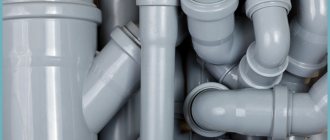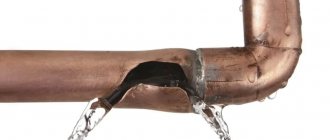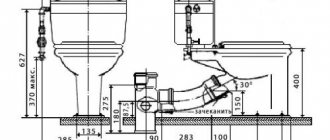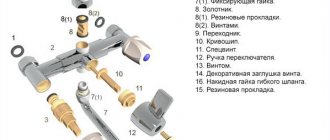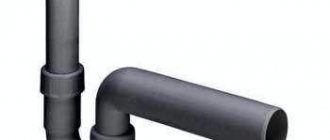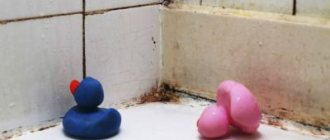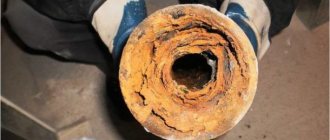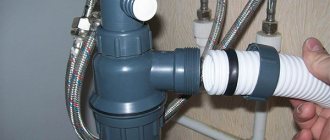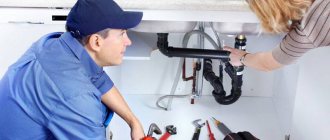Reasons for appearance
An unpleasant odor in the toilet appears due to malfunctions in the drainage and ventilation systems, as well as from deposits of urinary stones and feces on the toilet.
Blockages
In the clog formed in the toilet bowl from feces, dirt, hair, toilet paper, a process of decomposition occurs. The accumulated gas begins to seep through the water seal into the toilet.
Errors
Errors in design or installation lead to the appearance of odor from the toilet.
Clogged ventilation ducts
Ventilation ducts require regular inspection, cleaning of dust and cobwebs to maintain proper air exchange.
Presence of mold, mildew
The smell of mold is present when there are subtle leaks from pipes and siphons.
Insufficient ventilation
Vapors of ammonia and hydrogen sulfide can be felt in the bathroom if the drain pipe on the roof is frozen.
Faulty plumbing fixture
An unpleasant odor appears in the apartment if the toilet flush does not work. Feces and urine do not go down the drain, but remain in the toilet seat, forming sediment on the wall.
Poor sealing of joints
Failure of the seal between the elbow and the sewer riser is the reason for the penetration of stench from the drainage system.
Poor quality, untimely cleaning of the premises
Without complying with sanitary and hygienic requirements for maintaining the toilet, the stench from the toilet will spread throughout the apartment.
Aromas from the yard, neighboring apartment
The installation of fans on hoods, in the bathrooms of neighboring apartments, and the proximity of garbage containers is the reason for the entry of “fragrant” air into the bathroom.
Why is there an unpleasant smell in the toilet?
You can use a variety of means, but the unpleasant smell does not disappear. To get rid of it forever, you need to establish the cause of its occurrence.
It is imperative to inspect the entire sewer system. If you have a combined toilet, then you need to look at the pipes that extend from the bathtub and sink. If all the fasteners are not sealed, then perhaps the smell is coming from there.
The second reason may be improperly installed or clogged ventilation.
But, if in the first cases everything is fine, then you should clean the toilet more thoroughly and monitor the hygiene of the room. Perhaps the reason lies in the smell of tobacco and the urine that remains on the toilet.
Ways to maintain aroma
You can create a pleasant atmosphere in the toilet without resorting to household chemicals.
Chopped soap bars
Toilet soaps have a strong aroma. A few bars of soap in the toilet will mask the unpleasant odor.
Coffee beans
Coffee beans have a bright and persistent aroma that lasts for 1-2 days.
Fragrant herbs and spices
Spices (cinnamon, cloves) and herbs (wormwood, tansy) have a strong and pleasant aroma. The persistent smell lasts for a week. Glass containers are used for storage.
Essential oils
Essential oils, when evaporated, drown out any odors.
Flavoring based on improvised means
The flavoring is easy to make yourself.
Vodka and essential oil
An air freshener is made from vodka (50 milliliters), water (15 milliliters) and a few drops of any essential oil. The liquid is sprayed through a spray bottle.
Water and white vinegar
A mixture of white vinegar and water has a pleasant smell that lasts for one to two hours.
Gelatin, salt, essential oil
The aromatic gel is prepared on the basis of gelatin. Gelatin is poured with water until it swells, then heated over low heat until completely dissolved. Add a tablespoon of salt and 20 drops of essential oil (optional). For gelling, place in the refrigerator. The frozen gel is cut into pieces and laid out into molds.
Rice
Rice is poured into a metal canned vegetable cup and soaked in an aromatic composition: essential oil/infusion of spices/herbs.
Citrus peel
Orange and lemon peels are placed on the bottom of a glass jar, filled with vodka, closed with a lid and left for 2 days. The resulting liquid is poured into a spray bottle and used as an aerosol.
Problems with the operation of the water seal
The most common reason why a toilet smells like sewage is considered to be a malfunction of the water seal. Siphon , installed under the toilet, has a water plug that acts as an obstacle to the flow of aroma from the waste system. If the specified plug is missing, the smell will be able to spread freely, first through the bathroom, and then throughout the entire apartment.
The siphon, located under the toilet, is made in the form of a curved pipe. A certain amount of water accumulates in this part. It is the water seal that plays the role of an effective obstacle to the spread of unpleasant odors. Therefore, the smell of sewage in the toilet, what causes it and how to eliminate it, should be understood after checking the functionality of the water seal.
toilet water seal
Siphon operation
If the functioning of the siphon is significantly impaired, the home will constantly be filled with sewer smell. Therefore, it is worth studying the main problems associated with the malfunction of the water seal and the inability of this part to perform its assigned duties.
- Errors when installing the siphon. Mistakes made during installation work with the water seal can trigger the entry of a specific aroma from the sewer into the room. Often, when installing a bottle siphon at an excessive distance, an outlet pipe is mounted to the riser. In this situation, gases from the waste system will “climb” over the water plug and spread throughout the bathroom and the entire apartment.
- Drying the water plug. When the toilet is not used for a long time, the water plug dries out. This becomes the answer to the question why the toilet smells like sewage. In this case, the problem is resolved quickly. It is enough to ensure that water enters the water seal until the elbow of the part is completely filled. Drying out of a water plug is considered to be a fairly common occurrence in bathrooms that are not used for their intended purpose. However, the cause of the unpleasant odor can be eliminated without the help of specialists and in the shortest possible time.
Corrugation stretching
When the siphon is a plastic product connected to the system using a corrugated pipe, the appearance of a specific aroma is associated with sagging of the corrugation. This is why the toilet smells like sewer. What to do in this case? Often, this situation arises when simple adhesive tape or insulating tape is used to secure the knee, rather than special clamps prescribed according to the technology. When selecting corrugations for connecting a toilet, the apartment owner must take into account the likelihood of the part stretching over time. Simply put, you shouldn’t save on corrugation if you don’t want to “enjoy” sewer aromas throughout the entire apartment after a few months.
Incorrect installation
Incorrect installation of compressed corrugation, which causes the toilet to smell like sewage. What to do and why does it smell? The fact is that a stinking smell from the waste system will appear in the bathroom due to a violation of the technology for installing the compressed pipe. In this case, we are talking about insufficient bending when forming the siphon. When installation work is carried out by an inexperienced plumber or on their own, very often the corrugated pipe is not bent at the knee and is not fixed in the specified position. That is, the bending of the pipe will not be sufficient to create an obstacle to the spread of unpleasant gases. It is important to understand that, in addition to aroma problems, errors in installing corrugations can lead to malfunction of the entire plumbing complex.
Siphon clogged
Water seal clogged
Banal garbage that clogs the siphon will also affect the smell of sewage in the toilet. What to do and what is the reason for the aroma? The fact is that waste water settles on the inner walls of the knee and decomposes over time, releasing a sweet aroma in the process. If the problem is a clogged water seal, then to eliminate the cause of the smell, simply wash the part. If the blockage is severe, then it is recommended to use special chemicals sold in specialized stores for flushing. In some situations, manual cleaning of the part may be necessary. If a bottle-type siphon is installed in the system, it is easy to clean without removing it.
Problems with poor ventilation
In a room with a bathroom, ventilation is arranged to remove odors and moisture. Apartment buildings are ventilated by a built-in duct, which has a connection to all apartments in one entrance.
The stationary channel with natural exhaust has good traction. The bathroom in the apartment is equipped with a grate, which is fixed at the exit to the riser. Over time, dust, cobwebs and small debris accumulate on the surface of the grille.
Eliminating the problem
The grate that goes into the bathroom needs to be cleaned regularly. To do this, you need to remove it; if there is a rough coating, clean it with a scraper.
The nearby walls of the canal should be cleared of debris . Hardened mortar residues or large objects should be removed. Clean the walls of the canal with a toilet brush. Place the washed grate in its original place.
Recommendations
The following tips will help you deal with toilet smell
The toilet seat also needs timely cleaning and replacement, as it can also serve as a source of unpleasant odor and a breeding ground for pathogenic microorganisms.- You can freshen the air in the toilet using a hanging product for your car. It can, for example, be attached to a ventilation hole.
- Using steel wool may damage the toilet.
- A malfunctioning tank is one of the common problems that can lead to poor flushing of the toilet and, as a result, provoke the appearance of an unpleasant odor.
Rags, buckets of water, dirty brushes and other cleaning products can themselves become a source of unpleasant odors.
You will find a lot of useful and important information about removing various unpleasant odors from objects and surfaces in this section.
Incorrectly installed corrugated pipe
If the rules for installing corrugated pipes are violated, an unpleasant toilet smell may also appear. In particular, we are talking about the incorrect formation of a bend on a corrugated siphon pipe. Most often, a simple home craftsman does not know how to properly form a corrugated elbow and secure the hose in this position. The solution to the problem is to create the correct configuration of the corrugation and fix it with special plastic clamps. If you have doubts about your own abilities, you can always invite a professional plumber.
Fighting methods
It is quite possible to cope with odors from the toilet in various ways. Good results can be achieved by:
- folk recipes;
- fresheners;
- purchased cleaning products;
- use of acids, alkalis, chlorine.
Complex processing may require a combination of several options. For example, the use of cleaning products and the use of air fresheners.
How to eliminate it using folk remedies?
Simple ways to combat unpleasant odors allow you to use the means and substances that you already have in your household to achieve the effect.
Soda
Baking soda powder tends to absorb odors . In order to refresh the space of the toilet room, you can place a bowl of baking soda in the room.
Vinegar
In cases where the smell needs to be eliminated quickly, a recipe based on table vinegar is suitable. To do this, pour an arbitrary amount of vinegar into a container with hot water.
The hot solution will evaporate, causing the smell of vinegar to cover up the unpleasant odor from the toilet. The effect of this method is not long-lasting.
Soap
Some types of cosmetic soap have such a strong aroma that they can be used as a scenting agent. A few pieces of this soap will solve the problem if you place them in the toilet room. It is advisable to use soap with the same scent .
Coffee
Coffee beans have the ability to emit a fairly strong characteristic odor. You can take advantage of this by pouring some grains into a decorative bowl. You will have to change the fragrance every 1-2 days.
Essential oils
Natural essential oils have a fairly strong aroma. Their scent develops best when heated.
If there are pipes with hot water in the room, then you can drop a few drops of oil onto a damp handkerchief , which should be placed on the hot pipe.
An alternative option is to apply the oil (a few drops) to the switched off light bulb. When you turn on the light, the oil will evaporate, refreshing the room.
Acid and alkali
Caustic soda can be used to clean the toilet and eliminate odors. At its core, it is an alkali.
Application procedure:
- Scoop out the water from the toilet.
- Pour in the alkali solution.
- Leave for several hours.
- Treat with a brush.
- Rinse off with plenty of water.
Instead of alkali, you can use products with acid - vinegar, citric acid (it must first be diluted in water), etc.
Such products are simply poured into the toilet and left for several hours. After this, clean the surface and rinse with water. For stubborn stains, re-treatment may be necessary.
Preparations with chlorine
Products containing chlorine, such as bleach, allow you to clean the surface of the toilet , disinfect it and eliminate unpleasant odors. The disadvantage of this use is the specific aroma of chlorine itself and the fact that the substance is toxic.
You can use the whiteness gel by applying it under the headband. It is possible to use chlorine-based preparations as a last resort, using personal protective equipment, and only with good ventilation.
Air fresheners
All air fresheners can be divided into three main groups:
Deodorizing air. Such fresheners neutralize molecules that cause an unpleasant odor.- Masking unpleasant odors. Aromatization of the toilet allows you to hide the unpleasant odor, drowning it out with a pleasant one, with a pronounced fragrance.
- Combined means. They combine the first two options.
Air fresheners are available in different forms:
- sticks,
- gel,
- aerosol.
How to get rid of it using special sewer cleaning products?
Purchased products allow you to maintain the hygiene of the toilet - they eliminate not only unpleasant odors, but also limescale and other organic pollutants. The rating of toilet and bathroom cleaning products is presented in this article.
Domestos
Domestos series products are designed for high-quality care and cleaning of the toilet , disinfection of plumbing fixtures and removal of blockages. The cleaning solution is produced in gel form, which is well distributed over the surface. The main active substance is sodium hypochlorite.
If the condition of the toilet is neglected, it is recommended to leave the applied product for several hours to work. With regular use, Domestos works faster. After exposure, rinse off the product with water using a brush.
Advantages of use:
- elimination of specific toilet odors;
- disinfection;
- removal of lime and urinary stones;
- Ease of use;
- economical consumption.
The downside is the price. Cost – up to 200 rubles.
Chistin
The product is based on sodium hypochlorite. Available in gel form, which allows for high-quality surface treatment.
Advantages:
- low price;
- odor elimination;
- suitable for all types of pipes;
- removal of organic deposits.
Minuses:
- acrid odor;
- re-processing may be necessary;
- does not remove lime.
Price – about 70 rubles.
Cilit Bang
The drug is a fairly aggressive gel based on oxalic acid. The product is very effective in cleaning plumbing fixtures and eliminating odors.
Advantages:
- plaque removal;
- removal of odors;
- whitening;
- disinfection.
Minuses:
- high price;
- toxicity;
- not suitable for metal processing.
Price – about 170 rubles.
Repairing old leaks
Hidden toilet leaks may not cause too noticeable flooding, but sewer odor may be present. However, even a well-functioning ventilation system will not be able to eliminate the stench completely.
Important! As a rule, such microcracks are located in the upper part of the sewerage pipeline, so wastewater does not seep through them, but odors can constantly escape. The only problem is detecting microcracks. If the leak is located on a section of the pipeline located in the interfloor ceiling, then it is almost impossible to find the location of the hidden defect.
We identify the problem area
To make it easier to find such places, you can use a brush and soap solution:
- This solution is applied to the joints where there is the greatest likelihood of depressurization.
- Next, the water is drained into the sewer. Due to the fact that the air pressure becomes higher, air can escape through joints and microcracks. Using a soap solution will cause bubbles to form in such areas.
- If you find a leak in a plastic pipeline, then a special sealant should be applied to this place. On cast iron sewer pipelines, leaks are sealed by cold welding.
Measures to prevent microcracks
To avoid the question of why the toilet stinks of sewage, you should use preventive measures that will help protect the pipes from hidden leaks:
- To assemble the sewer system, use only high-quality products.
- If you use hidden placement of utility lines, be sure to install rubber hatches to monitor the condition of the system.
- Try not to design the sewer system so that the number of joints, connections and repetitions is minimal. This way you will reduce the likelihood of leaks and blockages.

